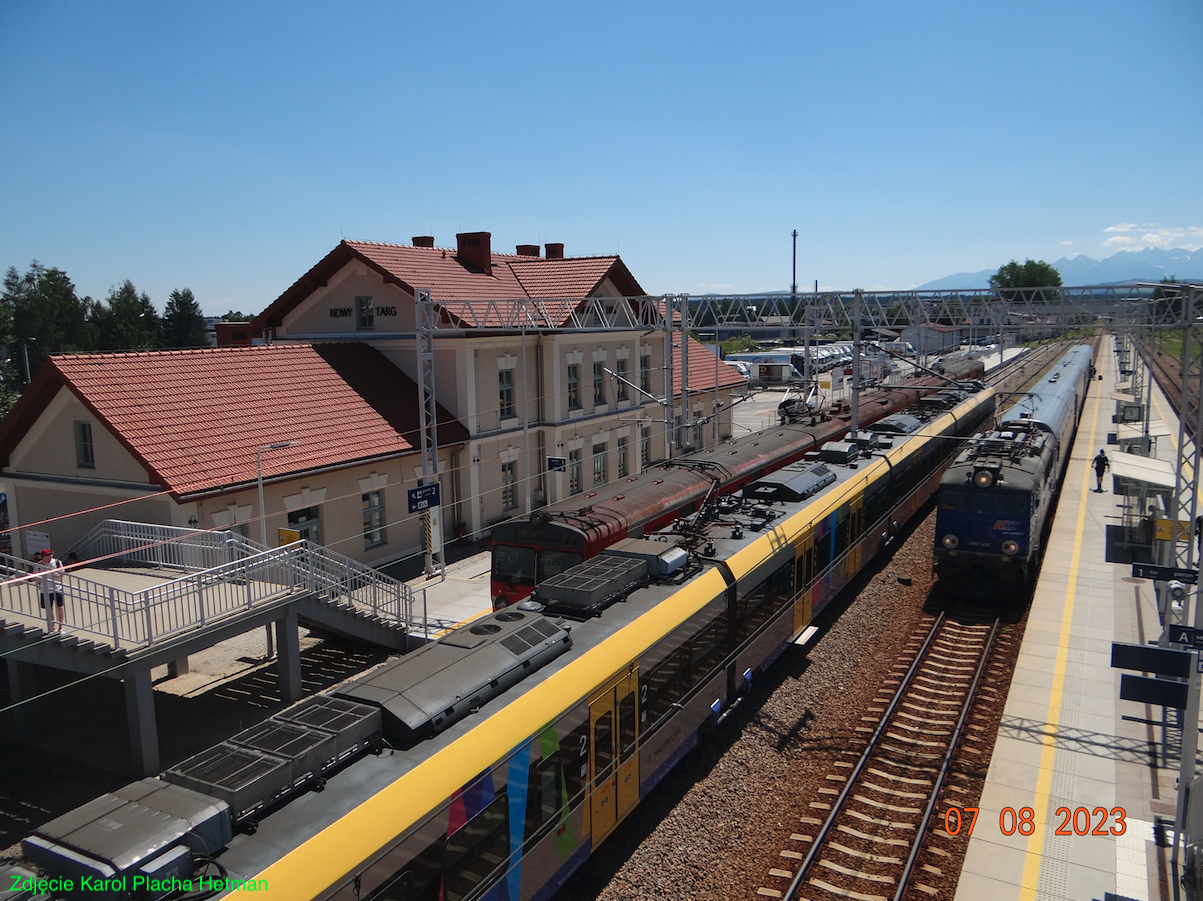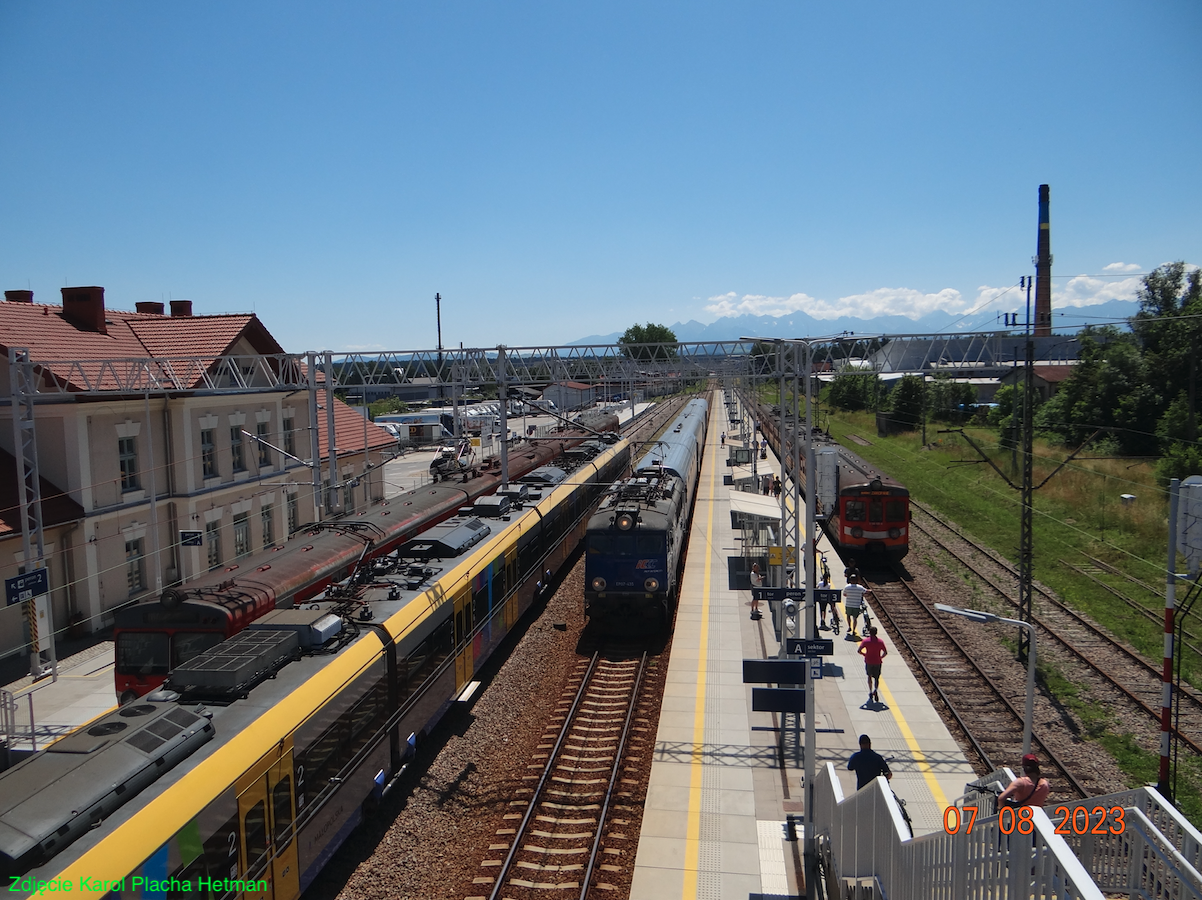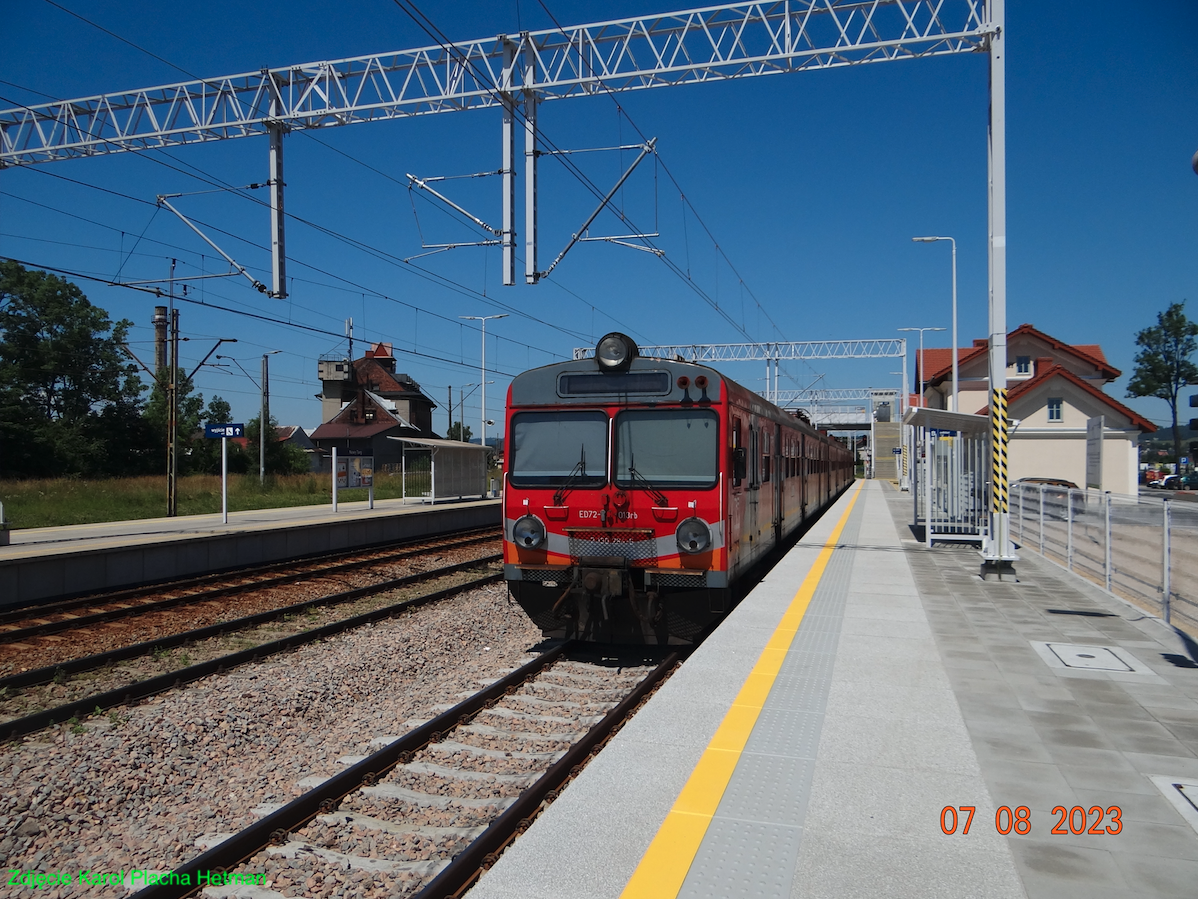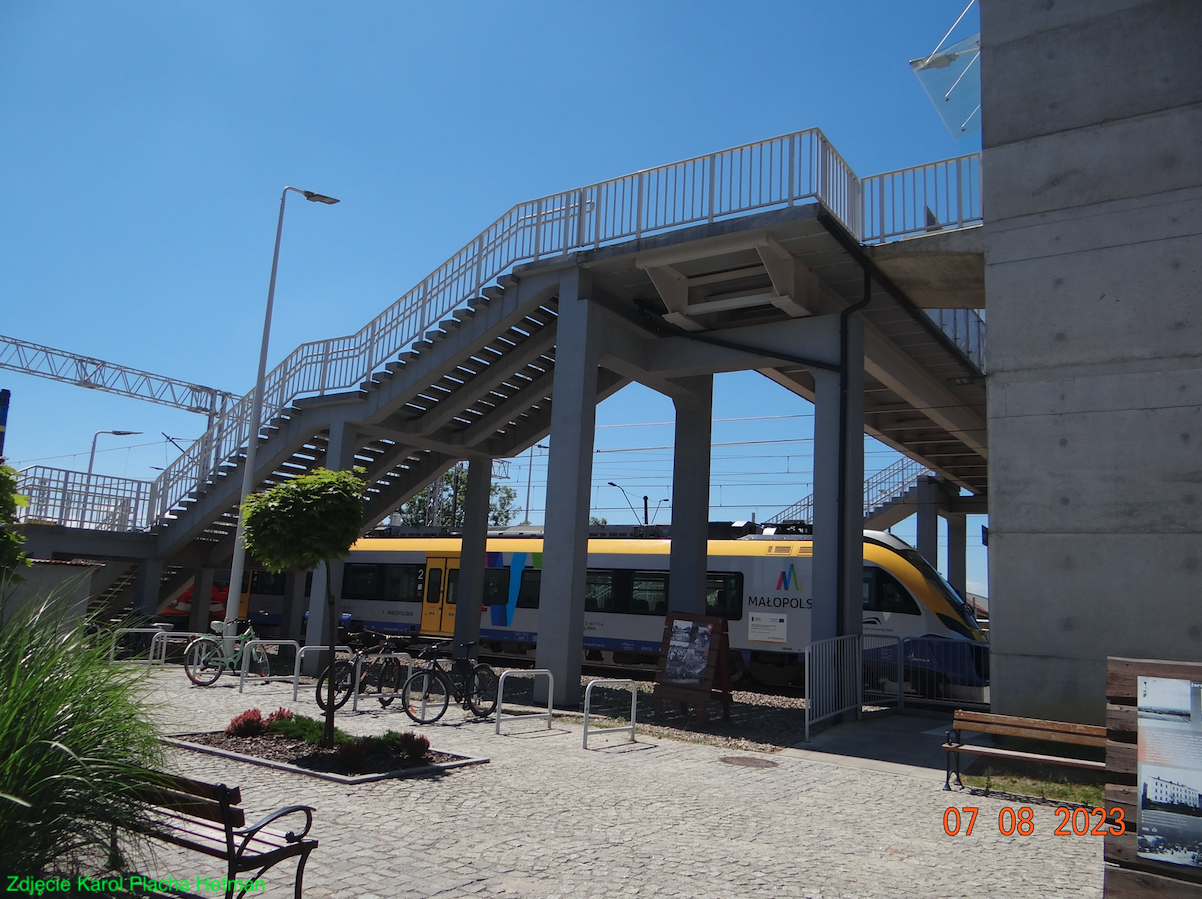Nowy Targ 2023-07-21
Railway station in Nowy Targ.
Geographic coordinates: 49.473N 20.015E. Elevation 601 m.





History of the City of Nowy Targ.
The beginnings of settlement in Podhale date back to the 13th century. It was then that the Cistercians came from Jędrzejów and founded a monastery in Ludźmierz. They received the right to establish new settlements in Podhale. Settlements stood on the trade route from Silesia to Hungary. At that time, Nowy Targ was built, which was then called Novum Forum. It was founded on Western European law. A parish existed here as early as 1326. Casimir the Great took over Podhale from the Cistercians and thus it became royal. It was then that it was decided to move the settlement to better ground and Casimir the Great again granted the town the privilege of location (June 22, 1346). In this way, a new town was created with a market square and the parish church of St. Catherine. Nowy Targ received many royal privileges, which contributed to its development. Trade and crafts flourished. By royal permission, each year on November 25 at St. Catherine, there was a huge fair. The fair lasted eight days. In 1487, King Casimir IV Jagiellon allowed a second annual fair on July 25 in St. James, which also lasted eight days. Thereafter, weekly fairs on Thursdays were allowed, which have continued to the present day. In 1521, King Sigismund the Old allowed the city councilors to collect tolls from the roads of Podhale, in exchange for their hardening and maintenance. Merchants who passed through Podhale were not allowed to avoid the city. In the 16th century, in Nowy Targ there were already guilds gathered in the Guild of Various Crafts. Furriers, however, were the most numerous and later formed their own guild. King John Casimir allowed the third great fair in a year; the first Sunday after Easter. The town had about 500 inhabitants in the 15th century, and about 800 in the 16th century. In 1601, the city was consumed by the first great fire. The fire burned almost the entire city, including the church, hospital, town hall, manor house. The taxes paid by the City were a significant item in the royal budget. While the townspeople and craftsmen in Nowy Targ fared well, the peasants fared much worse. Starosts introduced new taxes and labor every move. Dissatisfied residents of Podhale sent complaints, won cases in court, and yet their financial situation continued to deteriorate. There were revolts and even attacks on the castle in Czorsztyn. However, they were bloodily suppressed. Nevertheless, Podhale residents took part in the uprising against the Swedes, who in 1656 plundered the city and murdered most of the inhabitants.
In 1772, the First Partition of the Republic of Poland took place and the city came under Austrian administration. From the end of the 17th century, the slow decline of the city dates back to. One of the reasons was subsequent fires; 1673, 1696, 1710, 1719, and 1784. To this must be added epidemics and persecution of the occupiers. Under Austrian administration, Podhale was incorporated into Galicia. The property of the starosty was confiscated and privatized. Although the Austrian authorities retained the privileges of Nowy Targ, the city had to pay high taxes to the occupier and provide recruits. After the last great fire (1784), the city was rebuilt on a new street grid plan, without taking into account the former buildings and the distribution of plots. The market has been greatly enlarged. In 1840, the city already had 2,000 inhabitants. After the Spring of Nations, serfdom was abolished in Podhale. Later, Galicia received autonomy, and Nowy Targ became the seat of the county and the court. At the end of the 19th century, Nowy Targ had a school, mills, sawmills, a brewery, a power plant and many craft workshops. Since 1881, there has been a fire brigade, then called the fire brigade. The brick town hall was built in 1884, and it still exists in this condition. In 1899, the Chabówka-Zakopane railway line was opened. Education and the Sokół Gymnastic Society developed. Before the Great World War, Nowy Targ had 9,000 inhabitants.
During the Great World War, the inhabitants of Podhale fought on the side of the Austrians. This was due to the roots of most recruits. At the end of 1914, the Muscovites were defeated at Limanowa and then at Gorlice (May 1915) and retreated to the east. On the night of October 31 / November 1, 1918, Nowy Targ was taken over by the Polish Army. Civilians and high school students took part in the fighting.
In the Second Polish Republic, the city developed systematically. New important objects were built; a brickyard, another sawmill, and in 1930, an airport.
After the aggression of the German army, Nowy Targ was occupied by the new occupier already on September 1, 1939, around 4:30 pm, without a fight, entering from Slovakia. During the occupation, the whole of Podhale became one huge point of resistance. It was from the population of Podhale that the couriers, liaisons and guides between the occupied Republic of Poland (the Underground State) and the Government in exile in London came from. The Germans started the Germanization campaign in Podhale, trying to prove that the highlanders come from the Goths just like the German race. However, a small percentage of the population of Podhale went to cooperation. In 1941, a large anti-occupant network was already operating in Nowy Targ. Underground magazines were published, even in German. However, in 1942, the net was broken. Many people lost their lives during quick executions or ended up in extermination camps ("monuments of German civilization"). Some members of the network escaped, among them Józef Kuraś "Ogień". On January 29, 1945, the city was occupied by the Russians, who were shown the way by the "Ogien" unit. The Germans were so surprised that they fled in panic, without a fight.
In the new reality, the communists took power. The head of the UB (poviat public security office) was to be Józef Kuraś "Ogień". He was supposed to appear at the Krakow UB, but he turned back and returned "to the forest". Communist symbols were erected in Nowy Targ; museum of Lenin, monument to Russian soldiers (blown up twice). It was not until 1951 that the church was completed, the construction of which began in the Second Polish Republic. In 1955, Nowy Targ Zakłady Przemysłu Skórzanego "Podhale" was launched, which in its heyday employed 10,000 employees. New housing estates were built. In 1979, a holy mass was celebrated at the airport by Saint John Paul II the Great. In 1979, construction began on a new hospital, which was completed in 2008.
Railway station in Nowy Targ.
The railway line from Chabówka through Nowy Targ to Zakopane was opened on October 25, 1899. On July 1, 1904, the station in Nowy Targ became a junction station, because the railway line to Sucha Góra was opened. The station was called Neumarkt and Dunajec. A locomotive depot and a water tower were built in Nowy Targ, and two water cranes were placed by the tracks.
A major reconstruction of the station in Nowy Targ was carried out in 1975. An island platform and a footbridge over the tracks for travelers were built at that time. It was related to the electrification of the section of the Chabówka - Zakopane railway line, which was ceremonially launched on December 3, 1975.
An event in the history of Nowy Targ was the liquidation of passenger connections to the Nowy Targ Fabryczny station in 1987. In 1919, the railway line to the Podczerwone station was closed. The tracks have been removed. A bicycle path from Nowy Targ to Trstena in Slovakia was built along the track of the railway tracks.
Railway line No. 99.
Railway line No. 99 Chabówka - Zakopane is one of the most famous railway lines in Poland. The line is part of the Kraków - Zakopane route. The line is single-track and was electrified in 1975 with a 3 kV DC catenary. The line has a length of 43.785 km. The line has the largest number of passenger trains that connect Zakopane with the rest of Poland. The line was launched in 1899. The line is technically difficult and in the era of steam locomotives it was mainly serviced by tender-type steam locomotives, such as the following steam locomotives: TKt1, OKz32 (very good), TKt48 (very good). But there were also Ty-2/Ty-42 locomotives and derivatives on the route. Since electrification, the route has been mainly operated by EU07 electric locomotives and derivatives. Speeds on the line range from 60 to 90 km/h.
Despite the difficult terrain conditions, the line was built at a relatively low cost. This was due to the use of the route along the river valleys. It was typical design throughout the Carpathians. Therefore, trains cannot develop high speeds here. Counter-arcs were often used for the safety of moving trains. On the other hand, the railway can be used by residents of all major towns in Podhale. The disadvantage of running the tracks on the slopes by the rivers were initially landslides, which made the trail temporarily impassable. Running the line along the rivers caused the inclination of the tracks to reach 28‰ in some places. However, this does not cause problems for experienced mechanics.
Not a single tunnel or long flyover was built on the trail. Although at the beginning a tunnel was planned near the Sieniawska Pass. In such a situation, the line would bypass Raba Wyżna. Currently, it is not known whether the protests of the inhabitants of Raba Wyżna were against or for the construction of the railway line. As in many other places in the world, the construction of the railway line caused protests from the inhabitants of some towns, which ceased as soon as the benefits were noticed.
At the beginning of the 1970s, the route was electrified in stages. The first step; Chabowka - Nowy Targ was put into operation on November 18, 1975. The second stage; Nowy Targ - Zakopane was opened on December 3, 1975. On that day, the entire Krakow - Zakopane route was already electrified.
In the period 2017-2023, a general renovation of the entire Kraków Główny - Zakopane route was carried out. The renovation included track layouts, passenger stops and railway stations. All electrical traction has been replaced. All stations have been adapted to serve people in wheelchairs and travelers with bicycles. New passenger stops were created, for example in Chabówka. Rail traffic control devices were modernized and automatic control at rail-road crossings was introduced.
Currently (2023) works are being carried out at the Zakopane station. New, longer platforms and a new track layout will be built. It is planned to build a link between the railway line No. 99 and the railway line No. 98, which will make it possible to bypass the station in Chabowka and, above all, to change the head of the trains. This is the last place on the Krakow - Zakopane route, where it is necessary to detour locomotives around the depot.
Former railway line No. 118.
The railway line Nowy Targ - Sucha Góra is a liquidated railway line operating in the period 1904-1991. The line was 21.532 km long and ran along the provincial road No. 957 to Czarny Dunajec, and then along the Czarny Dunajec River. In 1918, the line was incorporated into PKP. After World War II, the border section was demolished. Polish trains were arriving at Podczerwone station. Passenger traffic on the line was carried out until 1987, and the freight spirit was stopped in 1989. In 1991, the line was physically decommissioned. Suchá Hora station was located in Slovakia. The line was local. It connected Nowy Targ - Infrared. Currently, a bicycle path runs along the railway track. The path is asphalt, three meters wide. The trail is 20.6 km long and runs through Ludźmierz, Rogoźnik, Stare Bystre, Czarny Dunajec and Podczerwone to the state border and then for 14.4 km on the Slovak side to Trstena. The route is suitable for recreational cycling and rollerblading. In Trstena there is a railway station and a further route of the Transversal Railway. In 2015, the historic railway bridge over the Czarny Dunajec River in Czarny Dunajec was renovated. It is now a pedestrian and bicycle bridge.
Nowy Targ station now.
The station is located at Kolejowa Street No. 66. The last renovation of the station was carried out in the period 2019-2021. The track layout was rebuilt to simplify the southern head of the station. Nearby is a historic building with a water tower. As part of the modernization of the station, a car park was built in the P+R system.
The station has 5 main tracks, 2 platforms and 3 platform edges. Platform 1, 245 m long, has a single edge with track No. 4 and is located next to the station building. Platform 2, 320 m long, is an island with tracks No. 1, 3. Access to the platforms is possible via a footbridge over the tracks. In 2021, the footbridge was renovated and equipped with lifts for passengers in wheelchairs, with large suitcases and bicycles. From the side of Chabówka there is an SKP station, which also serves the rail-road crossing along Ludźmierska Street (DW No. 957). The station has traffic lights. Radio communication channel R4.
Since 2018, the station and the building with the water tower have been owned by the city of Nowy Targ. In 2020, both the station and the historic water tower regained their former glory. The station is equipped with a ticket machine. There's no money. Inside the station there is a waiting room, toilets and railway information. Most of the building is occupied by railway services. The local branch of the Polish Tourist and Sightseeing Society also has its seat in the station building. The water tower is available to visitors on Mondays, Wednesdays and Fridays from 10:00 to 13:00. Free entrance.
In 2022, the Nowy Targ station served 150-200 passengers per day, and on holidays and Sundays even 300 passengers per day. In July 2023, 41 passenger trains left the Nowy Targ station daily. You could go to: Bydgoszcz Główna, Gdynia Główna, Katowice, Kraków Główny, Rabka-Zdrój, Szczecin Główny, Warszawa Wschodnia, Zakopane. Most of them were trains to Zakopane.
Written by Karol Placha Hetman
